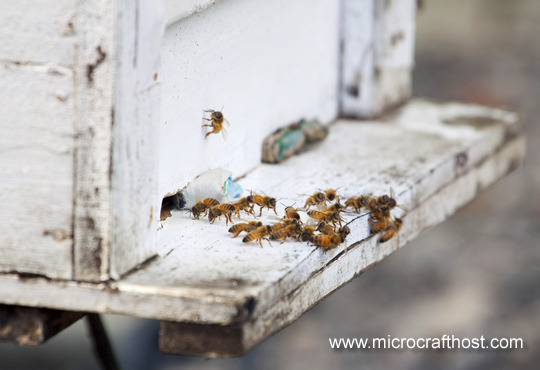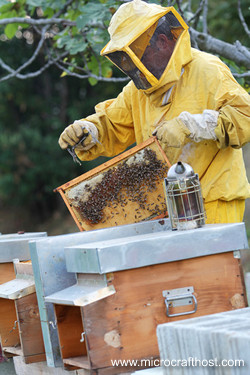Bees are the original micro crafters and a source of many products that we can use.

In handling bees, the bee is quick to perceive fear and to note sudden or quick actions. The person attempting to handle them must never permit himself to lose control of his every move and action. If they will go about handling the bees in a slow steady manner, without faltering and always using care to not crush or injure a single bee only where absolutely necessary, under ordinary conditions they will find the caring for bees an easy matter.
Bees have a special note of warning which they send out when angry, and an amateur bee keeper will soon learn to distinguish this note. It is then that the trying time begins in handling bees, should an angry bee light upon your bare hand or face, to make a quick move or jerk or to attempt to move the bee will not only provoke a sting from this particular bee, but will invite others in the vicinity to attempt the same. Should you permit the bee to alight, in many cases they will not attempt to sting when lack of fear is shown.
But only the old time bee keeper will boast of not being stung, the modern student and keeper of bees understands that bees will sting, and so prepares for this emergency. Of course, certain strains of bees do not sting as readily upon being provoked as others. It is important therefore, that in beginning with bees you obtain pure Italian bees as these show less inclination to sting than any other variety and are our best honey producers.
To distinguish a good Italian bee, one should note that the young bees are a beautiful golden in color and upon closer examination, have three or more golden bands about their bodies.
The life of the bee is one of the most interesting subjects you can imagine, and it is the more interesting from the fact that your studies will not only place you in close touch with Nature and many of her laws which you heretofore have been unable to understand, but at the same time will place you in touch with an interesting diversion from your daily occupation which will help to solve the high cost of living question, and bring in some ready money besides.
June is the month for the amateur to begin the keeping of bees. In most every publication you pick up you will find the advertisement of some bee supply house. By writing for one of these catalogues you can gather a working knowledge that will be sufficient for you to begin with. It is important that in beginning with bees you do not make the mistake of placing your bees in some handmade or old-fashioned hive, and therefore quite important that you get in touch with modern bee supplies through some bee supply house, as one of you first acts. You will find that the building of bee hives are one of the most carefully worked out arts you can imagine. The length, breadth and width of the bees body has been carefully studied for years by beekeepers, and the life habits and characteristics of the bee have been observed until today, the making of hives is so adapted to these observations and rules that it is not only impractical but foolhardy for the amateur bee keeper to attempt to work out these rules and build his own hives. Several large factories in different sections of the country do nothing else but make bee supplies, and have special wood-working machinery with which bee hives and supplies can be made in such large quantities, and so accurate that they do not vary scarcely the one-hundredth part of an inch. Being made in large quantities, of course they can be made much cheaper than they can be made by hand. Thus it will be seen that should you be so disposed, it would hardly be worth your while from an economical standpoint to make these bee supplies by hand.
 I will not here attempt to describe the different parts of a bee hive, but I want to give you a few suggestions that will aid you in beginning with bees during this present month of June. If you have some bee keeper in your community who has modern eight or ten frame hives you can possibly buy a new swarm or an old colony of bees from him. However, I would advise beginning right by obtaining two or three hives, ten frames preferred, knocked down, but all complete ready to set up. I would advise buying not less than two or three to begin with, as it is hardly advisable to keep only one colony of bees and the added expense in freight will add little if any to the additional cost for the second or third hive.
I will not here attempt to describe the different parts of a bee hive, but I want to give you a few suggestions that will aid you in beginning with bees during this present month of June. If you have some bee keeper in your community who has modern eight or ten frame hives you can possibly buy a new swarm or an old colony of bees from him. However, I would advise beginning right by obtaining two or three hives, ten frames preferred, knocked down, but all complete ready to set up. I would advise buying not less than two or three to begin with, as it is hardly advisable to keep only one colony of bees and the added expense in freight will add little if any to the additional cost for the second or third hive.
After setting up your hive according to instructions, having first painted the dove-tail and other joints before putting them together, your hive is ready for reception of the bees. You will find it advisable to use full sheets of foundation starter on your frames in the hive. This foundation or starter is pure bees wax which is poured in models which have the exact shape of the cells of comb honey you have noted with interest when you have cut through a section of honey. So in buying your hives, also buy enough sheets of foundation to equip your hive. Directions will be given as to how to fasten this starter in the frames. In buying this foundation for the frames you insure the bees working straight in the hive so that you can readily remove any frame at any time, just as you would a book from a sectional book case. In fact you will find that the modern bee hive is similar in this respect to a sectional book case, and as easily taken apart. This is the beauty of modern bee keeping.

If possible take your hive to a nearby bee keeper during the month of June, and remove the colony of bees to your home at night, after having securely tacked a small piece of screen over the entrance to the hive.
Or if you are unable to obtain bees at home, after having your hive ready for the reception of the bees, you can buy bees by the pound through reliable bee-keepers whose advertisements will be seen in the various bee Journals, and, bees can be purchased from your bee supply house in pound lots, with directions as to how to place in your hives. If possible, obtain some reliable book on bee keeping and study thoroughly the subject while you are beginning.
You need have no alarm about bees being a nuisance even on a small town lot but of course should be respectful of your neighbours and keep your hives away from them as much as possible. They should be placed in some unused corner of the lot where they can fly without being continually interfered with.